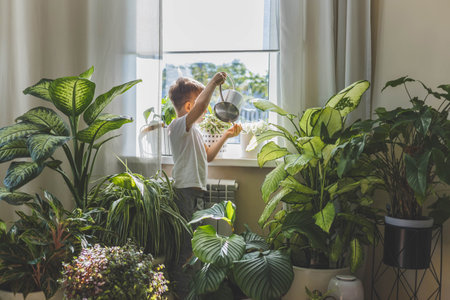Introduction: Urban Indian Apartments and WFH Culture
In recent years, the work-from-home (WFH) trend has become increasingly popular across major Indian cities such as Mumbai, Bangalore, Delhi, and Hyderabad. As IT jobs, startups, and digital businesses continue to grow, more professionals are finding themselves working remotely from their own homes. However, unlike sprawling houses or large villas, most urban Indians reside in compact apartments with limited space. These small flats often come with unique challenges—restricted natural light, less ventilation, and the need to efficiently manage both living and working zones within a confined area. With family members sharing the same space for work, study, and relaxation, creating a comfortable environment becomes even more essential. This shift in lifestyle has highlighted the importance of thoughtful home setups that support productivity and well-being during long hours spent indoors.
Benefits of Indoor Plants for Health and Productivity
For many urban Indians adapting to the work-from-home (WFH) lifestyle, indoor plants have become more than just decorative items. They serve as natural allies in enhancing both health and productivity, especially in compact city apartments where access to fresh air and greenery is limited. Let us explore how integrating houseplants into your WFH setup can offer holistic benefits, making your workspace healthier, more pleasant, and conducive to better work outcomes.
Air Purification: Breathing Easier Indoors
City living often means dealing with air pollution both outside and inside our homes. Certain indoor plants are known for their air-purifying abilities, helping to remove common toxins such as formaldehyde, benzene, and carbon monoxide from the air. This is particularly significant in Indian metro cities like Mumbai, Delhi, or Bengaluru where air quality can fluctuate due to traffic and construction dust.
| Common Indoor Plant | Key Benefit |
|---|---|
| Areca Palm (Supari Ka Paudha) | Filters toxins; increases humidity |
| Money Plant (Pothos) | Cleans VOCs; easy maintenance |
| Snake Plant (Mother-in-law’s Tongue) | Releases oxygen at night; removes pollutants |
Stress Reduction: Calming the Mind
The pressures of balancing home chores and office deadlines can take a toll on mental well-being. Studies show that tending to plants or simply having greenery in your view can reduce stress levels, lower blood pressure, and promote a sense of calm. In traditional Indian culture too, the presence of tulsi (holy basil) or neem has been associated with positive energy and peace within homes.
Mental Wellness Benefits at a Glance
- Reduces anxiety during hectic workdays
- Enhances mood with soothing natural visuals
- Encourages micro-breaks for plant care, refreshing the mind
Improved Concentration and Productivity
Distractions are plenty when working from home, from family members to urban noise. Research indicates that indoor plants can help boost attention span and memory retention by up to 20%. A green-filled workspace can encourage a focused mindset and increase overall work output—something every remote professional in India aims for.
How Indoor Plants Support WFH Professionals:
- Create a visually appealing environment for video calls
- Absorb background noise in compact apartments
- Instil discipline through daily plant care routines
By investing in suitable indoor plants, urban Indian professionals can create an oasis of health and productivity right inside their apartments, supporting both personal wellness and career goals while working from home.

3. Popular Indoor Plants in Indian Homes
For many urban Indian apartments, choosing the right indoor plants is both a practical and budget-friendly way to improve the home environment, especially for those working from home. Among the most beloved options are the Money Plant, Snake Plant, and Areca Palm. These varieties are not only widely available at local nurseries and markets but also easy to maintain and suitable for compact spaces.
Money Plant (Epipremnum aureum)
The Money Plant is a staple in Indian households and is often associated with prosperity and good luck according to Vastu Shastra. It thrives in indirect sunlight and can grow well in water or soil, making it ideal for apartments with limited sunlight. Many WFH professionals place Money Plants near their work desks or living room corners to enhance air quality and bring positivity to the workspace.
Snake Plant (Sansevieria trifasciata)
Known locally as Mother-in-Laws Tongue, the Snake Plant is valued for its ability to survive with minimal care. It is an excellent air purifier that helps remove toxins commonly found indoors, such as formaldehyde from furniture or cleaning agents. Its upright leaves require little space, making it perfect for small flats in cities like Mumbai, Bangalore, or Delhi.
Areca Palm (Dypsis lutescens)
The Areca Palm is another favourite due to its attractive feathery fronds and its efficiency in humidifying indoor air—a much-needed feature during dry North Indian winters or in AC-cooled rooms. This plant also adapts well to Indian climatic conditions and adds a tropical vibe to modern apartment interiors.
Affordability & Accessibility
All these plants are commonly available at reasonable prices across India—from street vendors to large garden centres—making them accessible even on a modest budget. Their low maintenance requirements mean they suit busy lifestyles of working professionals without demanding excessive attention or care.
Cultural Relevance
Besides their health benefits, indoor plants like Money Plant have deep cultural significance in India, symbolising wealth and harmony. Including such greenery not only supports well-being during long WFH hours but also aligns with traditional beliefs cherished by many urban families.
Vastu Shastra and the Role of Plants in Indian Culture
When it comes to creating a harmonious environment for work-from-home (WFH) setups in urban Indian apartments, traditional Indian beliefs like Vastu Shastra play a significant role. Vastu Shastra, an ancient Indian science of architecture and design, emphasizes the importance of balancing natural energies within living spaces. According to these principles, certain indoor plants are not just decorative but are believed to bring positive energy, prosperity, and good health to homes and workspaces.
The Significance of Plants in Vastu Shastra
Plants are considered vital in Vastu Shastra because they symbolize growth, vitality, and abundance. Incorporating specific plants indoors is thought to purify the air, reduce stress, and enhance productivity — all crucial for those working from home in compact urban apartments. Additionally, some plants are believed to attract wealth or repel negative energies.
Popular Auspicious Indoor Plants According to Vastu
| Plant Name | Vastu Benefits | Ideal Placement |
|---|---|---|
| Tulsi (Holy Basil) | Promotes positivity and spiritual wellbeing | Near windows or balcony facing north/east |
| Money Plant (Epipremnum aureum) | Attracts wealth and prosperity; reduces stress | Inside the house, preferably southeast corner |
| Bamboo Plant | Brings luck and harmony; symbolizes resilience | On office desks or living room corners |
| Aloe Vera | Cleanses air; removes toxins and negativity | Near sunlight, kitchen or living area |
| Areca Palm | Enhances oxygen levels; creates a soothing atmosphere | Living room or beside workspace for freshness |
Cultural Practices and Modern Living
Many urban Indians blend these age-old beliefs with modern aesthetics by carefully selecting plants that align with both Vastu recommendations and contemporary décor trends. This practice not only supports spiritual well-being but also improves concentration and focus during long WFH hours. For families observing traditional customs, placing auspicious plants according to Vastu guidelines is seen as a simple yet effective way to enhance both the energy flow and functionality of their limited apartment spaces.
5. Practical Tips for Caring for Indoor Plants in Indian Conditions
Maintaining indoor plants in urban Indian apartments can be simple and rewarding, especially with a few practical strategies tailored for local conditions. Here are some easy-care routines and best practices to help your green companions thrive while you work from home.
Choose Low-Maintenance Plants
Select hardy varieties such as Snake Plant (Mother-in-law’s Tongue), Money Plant (Pothos), Areca Palm, or ZZ Plant. These species adapt well to typical Indian apartment environments and require minimal attention, making them perfect for busy professionals.
Watering Wisely
Overwatering is a common mistake. Most indoor plants prefer soil that is slightly dry between watering sessions. Test the top inch of the soil—if it feels dry, it’s time to water. In humid cities like Mumbai or Chennai, you may need to water less frequently than in drier places like Delhi or Bengaluru. Always use pots with drainage holes to prevent root rot.
Dealing with Humidity
Humidity levels vary greatly across India. For coastal cities with high humidity, ensure good air circulation around your plants by spacing them apart and occasionally wiping their leaves. In drier climates, increase humidity by misting leaves with filtered water or placing a tray of water near your plants.
Maximising Sunlight in Urban Flats
Many Indian apartments have limited sunlight due to closely built structures. Place your plants near east- or north-facing windows to catch gentle morning sun. If direct sunlight is scarce, rotate your plants regularly to ensure even growth and consider using sheer curtains to diffuse harsh afternoon rays during summer.
Fertilising and Maintenance
Feed your indoor plants with organic compost or diluted liquid fertiliser every 4-6 weeks during growing seasons (spring and monsoon). Regularly remove dead leaves and prune overgrown stems to keep plants healthy and attractive.
Pro Tip: Involve Family Members
Caring for houseplants can be a fun family activity. Assign watering duties or leaf-cleaning tasks to children or elders, making it a shared ritual that enhances everyone’s connection to nature—even in a city flat.
6. Space-Saving Ideas for Plant Placement
Urban Indian apartments are often compact, making it essential to use every inch of space wisely—especially when setting up a WFH corner. Fortunately, you don’t need a sprawling balcony or large windowsill to enjoy the benefits of indoor plants. Here are some creative, space-saving ideas that blend seamlessly with city living and Indian décor sensibilities:
Use Vertical Space
Maximise wall areas by installing floating shelves or wall-mounted planters. Hanging pots and vertical gardens not only look stylish but also leave precious floor space free for movement. Macramé plant hangers, which are trending in many Indian homes, add a boho-chic vibe and can be hung from curtain rods or ceiling hooks.
Choose Compact and Multi-Functional Plants
Select small potted plants like succulents, money plants (Pothos), or snake plants that fit easily on desks, window ledges, or even kitchen counters. You can also combine several small plants in a single decorative tray to create a mini garden without cluttering your workspace.
Utilise Corners and Unused Spaces
Corners are often overlooked in apartment layouts. Place tall but slender plants like bamboo palms or lucky bamboo in corners to add greenery without taking up too much room. Alternatively, stack two-tiered plant stands in unused nooks to display multiple plants vertically.
Repurpose Everyday Items
Get creative with items already available at home—old tea kettles, mugs, or clay diyas make unique planters and reflect Indian cultural aesthetics. Window grills can also double up as supports for creepers like English ivy or money plant vines.
Go Mobile with Movable Planters
If you often rearrange your WFH setup or need flexibility, opt for lightweight planters with trays or wheels. This makes it easy to shift your green companions around based on sunlight needs or changes in apartment layout.
Create a Plant Partition
For those seeking more privacy during video calls or wishing to visually separate work and relaxation zones, arrange taller indoor plants in a row to form a natural green partition. Areca palms or rubber plants are excellent choices commonly found in Indian nurseries.
With these smart placement ideas, you can integrate the refreshing presence of nature into your urban Indian home office without sacrificing valuable space—proving that even the smallest apartments can become lush, productive sanctuaries.
7. Conclusion: Enhancing WFH Experience with Greenery
Embracing indoor plants in urban Indian apartments is more than just a global trend—it is a meaningful way to enrich the work-from-home (WFH) lifestyle. By integrating greenery into our living spaces, we create a positive, calming environment that supports productivity and well-being amidst the hustle of city life. For many Indian residents, indoor plants carry deep cultural significance, connecting us to traditional values of harmony with nature and vastu shastra principles that encourage positivity and balance at home.
Whether it’s the air-purifying money plant on your desk or a tulsi near your window, these green companions bring vibrancy, fresh air, and even spiritual comfort to daily routines. They help reduce stress, improve focus, and provide a refreshing break from screens—all essential for an effective WFH setup. Adopting indoor plants also allows urban Indians to reintroduce a touch of nature into concrete surroundings, preserving an important cultural connection to greenery despite limited space.
In summary, nurturing indoor plants is a simple yet powerful step towards making your WFH experience more enjoyable, productive, and culturally rooted. Let your apartment bloom not only with work goals but also with the timeless beauty and positivity that plants bring into every Indian home.


